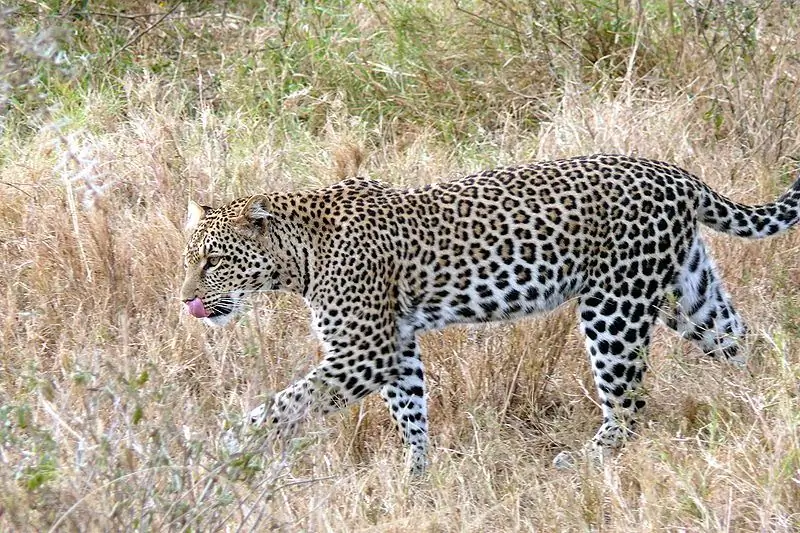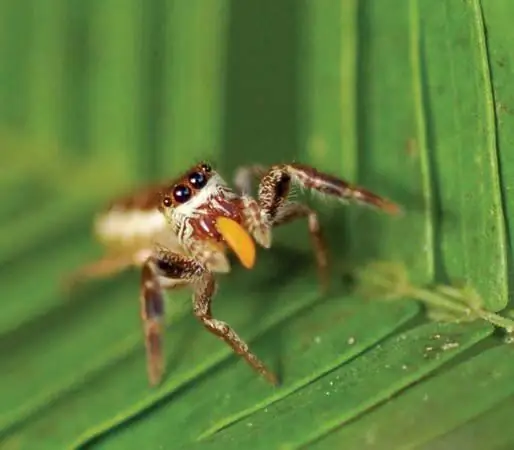- Author Henry Conors [email protected].
- Public 2024-02-12 02:40.
- Last modified 2025-01-23 09:07.
Felines have always attracted humanity. These animals are very graceful and agile, fast and have a magnificent color. Cats are kept at home, so we are not talking about the extinction of pets. But in the wild, there are fewer and fewer animals, and some species are generally on the verge of extinction. One of these is the clouded leopard.

General characteristics
This feline is intermediate between large and small wild cats.
In most cases, the color of the animal is light yellow, but there are individuals and rich brown. On the skin are large spots of various shapes. The color of the spots can be monophonic or slightly lighter towards the middle. The color of the chest and belly of the cat is light, with a small number of spots.
The average size of a clouded leopard (male in length, without a tail) is from 80 to 100 centimeters. The tail is quite long, up to 90 centimeters. The animal weighs about 20 kilograms, but some individuals reach 30. At the withers, the animal is up to 50 centimeters high.
The mammal boasts magnificent fangs, the length of which is about 3.5 centimeters. For an animal this size, these are fairly large teeth.
The skull of a leopard is elongated, the eyes are usually yellow, with oval pupils that are widely set on the muzzle.
Thanks to the long tail, the animal moves perfectly through the trees. The body of a leopard is strong. The animal searches for food mainly at night, looking out for prey from tree branches and catching up already on the ground. The diet is based on wild pigs and deer, sometimes the animal manages to catch cattle. It also feeds on birds and monkeys, reptiles and fish, porcupines. But in search of food in one day, you can walk no more than 2 kilometers.
The cat has excellent eyesight, it also sees great at dusk. It is believed that an animal has 6 times better eyesight than a human.
Animals in the zoo live up to 20 years, how long they live in the wild is difficult to establish, since there is no way to observe them in the wild.
Area
Today, the clouded leopard is found in the subtropics and tropics, in Southeast Asia. The cat lives in the foothills of the Himalayas, in Malacca and southern China, in Thailand, Myanmar and Vietnam.
The animal prefers rainy tropical forests, mainly at an altitude of up to 2 thousand meters above sea level. This animal can also be found in dry forests, wetlands.

Behavior
The animal leads an active lifestylearound the clock. It can hunt even during the day, but prefers the night. The leopard is an excellent swimmer and moves along horizontal branches. At the same time, it can lower its head down, hang on a branch like a sloth.
The animal lives alone, except for the mating season. The area occupied by one individual can reach 45 square kilometers.

Reproduction and offspring
A photo of an animal - a smoky leopard - will not leave anyone indifferent, especially if a baby is filmed. Almost no one has seen how animals breed in the wild, since the cat lives in hard-to-reach places and all information about the process was obtained only at the zoo. In captivity, the female gives birth to offspring in the spring.
Puberty occurs at 20-30 months of age. And pregnancy lasts from 87 to 110 days.
As a rule, the female gives birth to two blind kittens. It is extremely rare to have up to 5 babies. Babies weigh no more than 150 grams and at the beginning of life they practically do not move. The eyes open only at 2 weeks of age. And after about 1 month, the kids are already very active and very playful. Until the 70th day, kittens eat exclusively mother's milk, no meat. From the 5th month of life, the animal begins to eat meat. And by the 9th month, the animal can live and hunt quite independently.

Types and subspecies
Not so long ago in the scientific world there was an opinion that the smoky leopard is presented in a single form. Although three subspecies have been identified, one of which is consideredcompletely extinct - Taiwanese subspecies.
2 years (2006-2008) research disproved this theory. As a result, a new species was identified - the Bornean clouded leopard.
Kalimantic species
This is the second name of the Bornean leopard, which is the least studied species of cats and annual reports on the study of this animal gradually lift the veil about him. Most of the information researchers obtain in the process of observing animals that are kept in captivity. In the wild, the Bornean clouded leopard is a very rare animal.
The name of the beast was given by the same name of the island of Kalimantin or Borneo. This is the only island in the world that is not only a sea island, but is divided by three states:
- Indonesia;
- Malaysia;
- Brunei.
This species has also been seen on the islands of Sumatra and in Asia.
The island of Borneo itself is occupied by huge tracts of equatorial forest. Here is the most unique flora and fauna. Therefore, there is an assumption that it is here that you will be able to meet a smoky leopard, the coloring of which will be unique and it will be a new species of cats.
To date, it has not been established how many Bornean leopards exist in the world. For example, in Malaysia, in the state of Sabah, only 9 individuals per 100 square kilometers were counted. That is, we can conclude that this animal needs protection, as it is a vulnerable species.

Common characteristics and differences
When comparing Bornean andclouded leopard, the first one has longer and thicker fangs, and the jaw is also much more massive. On average, individuals of the Calimantian cat are from 75 to 100 centimeters. Males are much more sexually dimorphic, meaning they are much larger than females.
The color is also slightly different: in the Bornean species, the spots on the skin are much smaller and have a darker color. Inside the spots, as a rule, there are even smaller spots. The coat is much darker and has a gray tint, and a dark stripe is obligatory on the back. But the main difference is the structure of DNA, the codes for both animals are very different.

Protection status
Very little is known about how many clouded leopards live in the wild. Naturally, people pose the main threat; they cut down tropical forests, which are the habitat for this mammal. At this rate, it is possible that our children will only be able to see a clouded leopard in a photo.
Besides deforestation, people kill these cats for their beautiful fur. And the teeth of cats are used by local tribes for the preparation of folk potions. Back in some 1991 in China, many skins and teeth of a mammal were sold on the black market. It is for this reason that the Taiwanese leopard species has disappeared from the face of the earth. Although since 1975 the trade in this animal, its skin and teeth has been banned by CITES.
In most countries that are the natural habitat of this animal, it is protected by law. But, of course, that the law alone will not change the situation. The samefarmers are sure that leopards pose a huge threat to their farms by attacking livestock, although there are very few such facts.

Interesting clouded leopard facts
Few people know that this cat has fangs very similar to those of saber-toothed tigers, which have long since died out, but genetically they are completely different animals.
The natives of Borneo, the Dayaks, have always adorned themselves with cat fangs. Teeth were also a talisman. From the skins, these people sewed military uniforms for themselves and made carpets.
The smoky-looking leopard can't growl. The sounds coming from the animal's mouth resemble a cute cat's purr and purr. This is due to the fact that he has an ossified hyoid bone.
Despite the fact that the leopard is a predator, in the zoo it is more like a cute pet, which is very playful and good-natured. Also a reliable fact that, despite its name clouded leopard, the cat has nothing to do with leopards
And the Lukai people, who live in Thailand, believe that the smoky cat is their spiritual ancestor, who brought them to these places for permanent residence.






